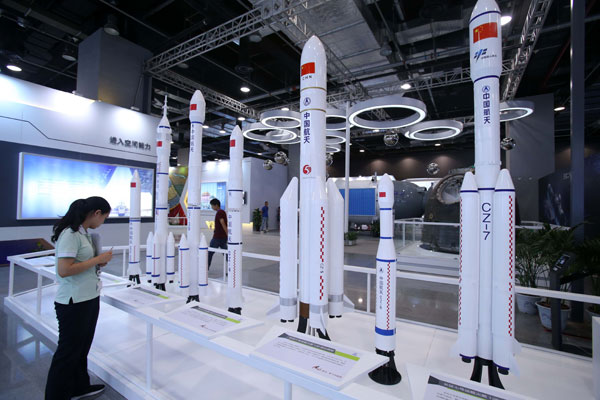Rocket scientists reach for the sky
Updated: 2016-10-07 07:41
By Zhao Lei(China Daily)
Hard work on the ground ensures dream of success can take flight
|
Models of rockets from the Long March series are on display at an aviation technology exhibition in Beijing on Sept 18. Chen Xiaogen / For China Daily |
Deng Xinyu, 32, has lived in Beijing since 2002 when he left his hometown of Huaihua in Hunan province, and moved to the capital to enter university.
In common with most of the capital's residents, he talks about the soaring cost of property, traffic and good restaurants. He likes movies and reading books on history.
But his main focus is out of this world, literally. Most of his energy and attention is devoted to one big thing - the Long March 7, China's newest and most powerful space rocket.
Deng, the father of a 3-year-old boy, is a senior engineer in the Long March 7 project team at the China Academy of Launch Vehicle Technology, the major developer of these rockets.
"Though the rocket's first flight was successful, we are not complacent. Actually, we are busy preparing for its second mission," Deng told China Daily.
"Because the Long March 7 is a brand new model, it is totally different from previous types so our design methods and difficulties were different."
China conducted the maiden launch of the Long March 7 on June 25 at the Wenchang Space Launch Center in the island province of Hainan. The rocket sent seven payloads, including a model of China's next-generation manned spacecraft and a space debris cleaner, into orbit.
Propelled by pollution-free fuel, the Long March 7 is capable of sending 13.5 tons of payload into low Earth orbit and 5.5 tons into a sun-synchronous orbit. With a take-off weight of 597 metric tons, it is currently the most powerful rocket in China's launch vehicle family as its payload capability is about 1.5 times bigger than that of the Long March 2F, the predecessor to the Long March 7, according to the China Academy of Launch Vehicle Technology.
"The capabilities of a nation's rockets determine the extent of its space activity," Deng said. Researchers at his academy, he added, are mostly in their 30s and they are committed to ensuring China realizes its space aspirations.
"I arrive in the office at 8 am every day and go home at about 8:30 pm. I also work at least one day over the weekend. Usually, I have only one supper with my family each week," he told China Daily.
"But I don't regret choosing this job and I am still energetic. This is because my job keeps bringing me new challenges and inspiration."
Over the past two decades, the world witnessed China's rise from a mediocre space player to an influential power. It has sent 10 spacecraft and 10 astronauts into space and will soon fulfill a new manned mission to transport two astronauts to a space laboratory.
The nation has also made three lunar exploration missions, including one that soft-landed a rover on the moon.
Currently, Chinese scientists and engineers are developing a permanent manned space station, which is set to be built in space from 2018 and will be put into service around 2022.
It is expected to become the world's only space station after the International Space Station is retired in 2024.
The country will also send an unmanned probe to Mars to orbit and land on the Red Planet around 2020, Chinese space authorities said.
Furthermore, Lieutenant General Zhang Yulin, deputy head of the Central Military Commission's Equipment Development Department, said in April that China will land astronauts on the moon in 15-20 years.
These ambitious plans to send manned craft into space require massive work on the ground and teams of researchers in institutes, like the China Academy of Launch Vehicle Technology, are racing against time.


